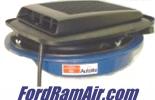I've run vacuum pumps on my car quite a bit over the last few years. I was running stock smog pumps on my FE motors and kept melting the vanes in them. Besides not being designed to run in an oily environment, I found out that I was turning them way too fast. I was told that 5000 rpm was about the max that I should be turning them and I was turning mine 7000+ rpm. When I switched over to the 460 I made a small pulley to fit the Fluidamper that runs the pump around 50% to 60% of crankshaft speed.
I ran a 4 vane Moroso pump with a relief valve on it when I first got the 460 running and it worked awesome. I burnt 3 pistons in it right away and never got the ring seal right after that because of 2 half-assed hone jobs to re-ring it twice after that.
I just got it running again with a different block that has a fresh, quality bore and torque plate hone job so the rings should seat right this time. I've got a 3 vane pump on it now without a relief valve (I'll get one if I need to) but I haven't run the car at the track yet.
It pulled 10" of vacuum at 3000 rpm in the driveway with about 5 minutes of runtime on it, so I think it's going to pull some good vacuum when the ring seal tightens up.
I can't tell you for sure what it was worth for power since I had so many other factors with breakage and whatnot, but it kept gaskets in it real nice and I was never able to run within a tenth of it's best time after I pulled the pump off....even after switching to alcohol for a while.
The reason I went with a vacuum pump in the first place is because I started running mufflers and lost the ability to run my traditional pan evac system into the collectors. After looking into running a pump I started hearing stories of power gains, I didn't look into a pump originally because I was looking for a power gain....I was just trying to keep gaskets in the motor.
------------------
Butch
460 powered 1967 Comet Cyclone
10.271 @ 130.231
Butcher's Home Page
"Friends don't let friends drive Chevys"











 Mustangsandmore Forums
Mustangsandmore Forums

 Ford Racing
Ford Racing

 Vacumn pump help please
Vacumn pump help please


